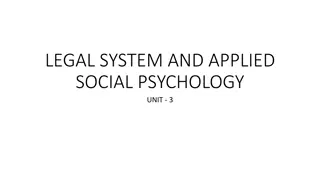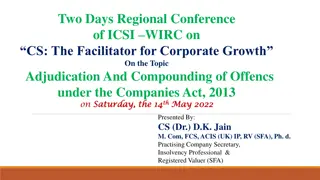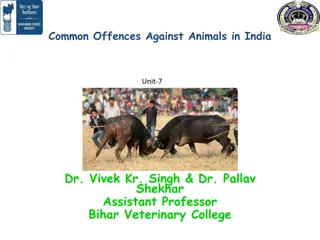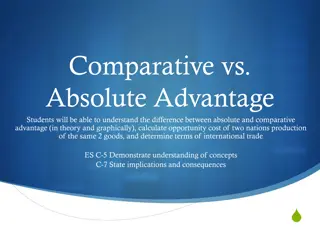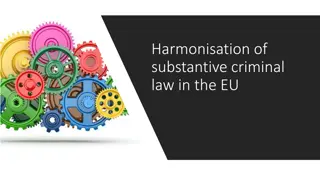Understanding Criminal Offences: A Comparative Analysis
Exploring the concept of criminal offences, this article delves into the definitions in common law and continental law systems. It discusses the structural elements, harmful nature, prohibition, punishment, and distinctive aspects of criminal acts. A comparison between common law and continental law systems is made regarding human conduct, mental awareness, liability avoidance, justification, and guilt aspects of criminal offences.
Download Presentation

Please find below an Image/Link to download the presentation.
The content on the website is provided AS IS for your information and personal use only. It may not be sold, licensed, or shared on other websites without obtaining consent from the author. Download presentation by click this link. If you encounter any issues during the download, it is possible that the publisher has removed the file from their server.
E N D
Presentation Transcript
VIOLENT CRIMES. dr Alicja Limburska INTRODUCTION
What is a criminal offence? different definitions in common law and in continental law criminal act might be defined by: its consequences its structural elements/characteristic Basic features of criminal acts harmful nature Prohibition and punishment conviction as distinctive aspect of criminal law
Crime is an event that is prohibited by law, which can be followed by a prosecution in criminal proceedings and, thereafter, by punishment on conviction Crime is an act usually deemed socially harmful or dangerous and specifically defined, prohibited, and punishable under criminal law
Structural elements of criminal offence substantially different in common law and continental law however, there are some common elements: some kind of human conduct as a basis distinctive, external features (other than non-criminal conduct) some type of mental awareness or at least possibility of such possibility of avoiding liability due to moral reasons, some kind of justification or excuse
Elements of criminal offence in continental law systems defining criminal offence by listing its structural elements consisting so-called dogmatic structure of criminal offence the number of elements creating criminal offence is not agreed upon
Classical definition of criminal offence in continental legal systems 1. human conduct naturalistic concept of an act 2. unlawfulness includes lack of justification 3. guilt psychological concept of guilt
Example of contemporary definition of criminal offence in Polish law (by A. Zoll) 1. human conduct (act or omission) 2. unlawfulness 3. punishability 4. social harm (higher than minimal) 5. guilt (culpability)
In this concept, criminal offence is a natural persons conduct (act or omission), which is unlawful (in violation with law), punishable by criminal law, which causes social harm higher than minimal, if the guilt might be attributed to the offender. Those elements might be found in Polish criminal code (art. 1):
Elements of criminal offence in common law systems 1. actus reus 2. mens rea 3. (lack of) defences actus reus + mens rea = prima facie offence
actus reus external ( objective ) element an event or conduct which causes the harm that the law is designed to prevent mens rea internal ( subjective ) element guilty mind such as intention, knowledge or recklessness actus non facit reum nisi mens sit rea an act does not make a man guilty unless his mind is (also) guilty fault element + state of mind (they are seen as separate in continental law) varies for each offence
the absence of a valid defence defences do not deny actus reus nor mens rea defences special circumstances that cause a prima facie offence not to be a criminal act it s not an alibi in a common understanding ( defence means something else in criminal procedure and substantive criminal law) 1) justifications - negate the wrongfulness of the conduct (eg. self-defence, necessity) 2) excuses negates culpability/fault (eg. insanity, duress)
ACTUS REUS one of constituent/obligatory elements of a criminal offence an event prohibited by law material / physical / objective element does not refer to the defendant s mental state
Elements of actus reus in common law behaviour circumstances consequences in continental (Polish) criminal law behaviour mandatory ( who kills a man shall be punished ) circumstances optional ( who kills a man with excessive cruelty shall be punished ) causality and consequences (outcome) - optional
Behaviour as a basis of actus reus in general it s a mandatory element of actus reus (with some exceptions in common law, eg. possessory offences, state of affair offences) no criminal liability for merely an intent/thoughts behaviour takes place in a form of an act or ommission
Circumstances as an optional element of actus reus non-mandatory most of circumstances as element of actus reus circumstances might element of actus reus the offences do not include specific be reflected as additional
Classification of offences depending on circumstances: the basic type based on the general characteristics of a given prohibited act; this type refers to the standard degree of social harm the act presents the privileged type in comparison to the basic type, it contains additional elements within a prohibited act s description that result in a more lenient assessment of the social harm the act presents the aggravated type in comparison to the basic type, it contains additional elements of a prohibited act s description that result in a more severe assessment of the social harm the act presents
Concecuences/outcome as an optional element of mens rea conduct crimes actus reus consists only of behaviour (breaking and entering, theft, reckless driving) result defendant s consequence actually to occur (murder, assault, criminal damage) crimes cannot be committed the specified unless result the or actions cause
MENS REA part of the offence referring to the defendant s mental state moral / mental element of criminal offence requirement of guiltymind substantial differences between common law and continental (Polish) law
Mens rea in common law it is possible for an offence to contain a variety of actus reus elements which the corresponding mens rea requirements differ includes guilt (not only psychological but also moral element) Examples of mens rea states: purpose, intention, recklessness, wilfulness, knowledge, belief, suspiction, reasonable cause fraudulence, dishonesty, corruptness neglicence to believe, maliciousness,
In common law, for the majority of offences it is not necessary to prove that the actus reus was intended, since recklessness will normally suffice for a conviction. Some exceptions: murder theft burglary wounding with intent
Main differences between intention and recklessness in both cases the defendant foresees the possibility of realising the actus reus the defendant acting recklessly does not seek and is not motivated to bring it about recklessness is established only if the defendant risked doing the actus reus unreasonably, while there s no condition of unreasonableness attaching to intention
Two types of negligence ordinary negligence gross negligence the defendant is negligent if a reasonable person in the same circumstances: 1) would have been aware of the risks of doing the actus reus, and 2) would not have run those risks gross negligence the defendant s conduct not merely fails to meet the standard set by the reasonable man test, but falls short of that standard by a considerable margin not merely unreasonable, but very unreasonable
Mens rea in continental (Polish) law an offence might only be intentional or unintentional (as a whole) guilt (culpability) and intentionality are separated normative understanding of guilt: ability to impute to a perpetrator a defectiveness of his or her motivational process: a perpetrator decides to perform a given act whereas in accordance with socially acceptable rules of conduct, he or she should have behaved differently (transl. K. Kremens, W. Jasi ski)
Possible mens rea states in continental (Polish) law: intention direct intention (one wants ) oblique intention (one foresees and accepts ) unintentionality recklessness (no intent but one is aware of being incautious) negligence (no intent, one is not aware of incautiousness, however should be aware; foreseeability)
Two layers (basic requirements) of intention: 1) awareness of the perpetrator the perpetrator needs to be aware of every element of actus reus 2) will (willingness) of the perpetrator the perpetrator wants (direct intention) or accepts (oblique intention) certain behaviour or the consequence
VIOLENCE - basic questions 1)Try to define what violence is. Can you think of different definitions? 2)Is violence a homogeonous or heterogenous phenomenon? 3)Can you distinguish different types of violence? What are they? 4)Is every case of a violent behaviour a criminal act? Why/why not? 5)Is there in your opinion a lot of violence in the today s world? From your experience is violence rate rising or rather declining?
Ad. 1. DEFINITION OF VIOLENCE World Health Organization: the intentional use of physical force or power, threatened or actual, against oneself, another person, or against a group or community, that either results in or has a high likelihood of resulting in injury, death, psychological harm, maldevelopment or deprivation National Research Council: behaviors by individuals that intentionally threaten, attempt, or inflict physical harm on others Encyclopedia Britannica: act of physical force that causes or is intended to cause harm; the damage inflicted by violence may be physical, psychological, or both
Ad. 2 and 3. VIOLENCE IS A COMPLEX SOCIAL PHENOMENON The nature of violence is heterogenous: physical psychological sexual economic Self-directed violence/interpersonal violence/collective violence Gender-based violence/rase-based violence/structural violence Familiy (domestic) violence/child abuse/elderly abuse Workplace violence (bullying)/hate speech/cyberviolence Warfare/terrorism
Source: Violence Prevention Initiative
Ad. 4. VIOLENCE VIOLENT CRIME(s) violence is rather a sociological/criminological term not legal criminal law refers to specific types of violent behaviour not to violence in general violent crimes are violations of criminal law that involve the intentional use of violence by one person against another Is a criminal penalty also a form of violence (accepted by state)?
Ad. 5 VIOLENCE IS EVER-SEEN SOCIAL PHENOMENON the most ancient traces of violence that have been found are those resulting from the practice of cannibalism collective violence seems to have appeared with the sedentarization of communities at the end of the Palaeolithic era, around 13,000 BC in the Near East corporal punishment can be traced back to the earliest civilizations, eg. the early law code of Ur-Namma, ruler of the Sumerian city of Ur (2112 2095 BCE, Mesopotamia) Source: https://en.unesco.org/courier/2020-1/origins-violence
Interesting trends in violence rates: https://www.ted.com/talks/steven_pinker_the_surprising_decli ne_in_violence




